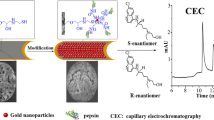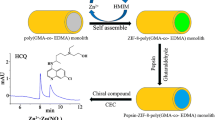Abstract
The inner wall of a capillary was coated with glycidyl methacrylate (GMA) to form tentacle-type coating, and poly(glycidyl methacrylate) nanoparticles (PGMA NPs) were then immobilized on the film. Ethanediamine-β-cyclodextrin as chiral selector was covalently bonded into the PGMA NPs through the ring-open reaction. The materials were characterized by SEM, TEM and FT-IR. The modified column was applied to the enantioseparation of the racemates of propranolol, amlodipine and metoprolol. Compared to a capillary with a single layer of CD-PGMA (without GMA coating) and to a CD-GMA system (without PGMA nanoparticles), the performance of the capillary is strongly improved. The effects of buffer pH value and applied voltage were optimized. Best resolutions (propranolol: 1.27, metoprolol: 1.01 and amlodipine: 2.93) were obtained when using the PGMA-coated capillary system. The run-to-run, day-to-day and column-to-column reproducibility were tested and found to be highly attractive. The new stationary phase is likely to have a large potential and scope in that it may also be applied to chiral separations of other enantiomers, such as amino acids and biogenic amines.

Schematic presentation of the preparation of a capillary column with glycidyl methacrylate (GMA) coating which was then immobilized with poly(glycidyl methacrylate) nanoparticles and ethanediamine-β-cyclodextrin. This novel open tubular column was applied to construct capillary electrochromatography system for separation of basic racemic drugs.





Similar content being viewed by others
References
Jahnchen E, Meinertz T, Gilfrich HJ, Groth U, Martini A (1976) The enantiomers of phenprocoumon: Pharmacodynamic and pharmacokinetic studies. Clin Pharmacol Ther 20:342–349
Paulsen O, Nilsson LG, Saint-Salvi B, Manuel C, Lunell E (1988) No effect of roxithromycin on pharmacokinetic or pharmacodynamic properties of warfarin and its enantiomers. Pharmacol Toxicol 63:215–220
Testa B, Reist M, Carrupt PA (2000) Chirality and drugs. Ann Pharm Fr 58:239
Geiger M, Hogerton AL, Bowser MT (2012) Capillary electrophoresis. Anal Chem 84: 577–596
Wang J (2005) Electrochemical detection for capillary electrophoresis microchips: a review. Electroanalysis 17:1133–1140
Ramos-Payán M, Ocaña-Gonzalez JA, Fernández-Torres RM et al (2018) Recent trends in capillary electrophoresis for complex samples analysis: a review. Electrophoresis 39:111–125.
Zhang K, Gao R (2013) Capillary Electrochromatography. Methods Mol Biol 69: A461–A467
Yang L, Guihen E, Holmes JD et al (2005) Gold nanoparticle-modified etched capillaries for open-tubular capillary electrochromatography. Anal Chem 77: 1840–1846.
Tanaka N, Nagayama H, Kobayashi H et al (2015) Monolithic silica columns for HPLC, micro-HPLC, and CEC. J Sep Sci 23:111–116
Guihen E, Glennon D (2004) Recent highlights in stationary phase design for open-tubular capillary electrochromatography. J Chromatogr A 2004(1044):67–81
Wang M, Yan X (2012) Fabrication of graphene oxide nanosheets incorporated monolithic column via one-step room temperature polymerization for capillary electrochromatography. Anal Chem 84:39–44
Dong X, Wu R, Dong J, Wu M, Zhu Y, Zou H (2008) A mesoporous silica nanoparticles immobilized open-tubular capillary column with a coating of cellulose tris (3,5-dimethylphenyl- carbamate) for enantioseparation in CEC. Electrophoresis 29:3933–3940
Zhang Q, Du Y, Du S (2014) Evaluation of ionic liquids-coated carbon nanotubes modified chiral separation system with chondroitin sulfate E as chiral selector in capillary electrophoresis. J Chromatogr A 1339:185–191
Qu Q, Gu C, Hu X (2012) Capillary coated with graphene and graphene oxide sheets as stationary phase for capillary electrochromatography and capillary liquid chromatography. Anal Chem 84:8880–8890
Yang L, Chen C, Liu X, Shi J, Wang G, Zhu L, Guo L, Glennon JD, Scully NM, Doherty BE (2010) Use of cyclodextrin-modified gold nanoparticles for enantioseparations of drugs and amino acids based on pseudostationary phase-capillary electrochromatography. Electrophoresis 31:1697–1705
Řezanka P, Navrátilová K, Žvátora P, Sýkora D, Matějka P, Mikšík I, Kašička V, Král V (2011) Cyclodextrin modified gold nanoparticles-based open-tubular capillary electrochromatographic separations of polyaromatic hydrocarbons. J Nanopart Res 13:5947–5957
Li M, Liu X, Jiang F, Guo L, Yang L (2011) Enantioselective open-tubular capillary electrochromatography using cyclodextrin-modified gold nanoparticles as stationary phase. J Chromatogr A 1218:3725–3729
Li Y, Wei M, Tong C et al (2016) Self-assembled cyclodextrin-modified gold nanoparticles on silica beads as stationary phase for chiral liquid chromatography and hydrophilic interaction chromatography. Talanta 160:72–78
Mayer S, Schmalzing D, Jung M, Schleimer M (1992) A chiral test mixture for permethylated beta-cyclodextrin polysiloxane gas-liquid-chromatography phases - the Schurig test mixture, LC GC-M. Sep Sci 10:782–78&
Liu Z, Du Y, Feng Z (2017) Enantioseparation of drugs by capillary electrochromatography using a stationary phase covalently modified with graphene oxide. Microchim Acta 184:583–593
Xu L, Dong XY, Sun Y (2009) Electroosmotic pump-assisted capillary electrophoresis of proteins. J Chromatogr A 1216:6071–6076
Wen Y, Feng Y (2007) Preparation and evaluation of hydroxylated poly(glycidyl methacrylate-co-ethylene dimethacrylate) monolithic capillary for in-tube solid-phase microextraction coupled to high-performance liquid chromatography. J Chromatogr A 1160:90–98
Zhang W, Piao S, Choi H (2013) Facile and fast synthesis of polyaniline-coated poly(glycidyl methacrylate) core-shell microspheres and their electro-responsive characteristics. J Colloid Interface Sci 402:100–106
Gao X, Mo R, Ji Y (2015) Preparation and characterization of tentacle-type polymer stationaryphase modified with graphene oxide for open-tubular capillary electrochromatography. J Chromatogr A 1400:19–26
Xu L, Cui P, Wang D, Tang C, Dong L, Zhang C, Duan H, Yang V (2014) Preparation and characterization of lysine-immobilized poly(glycidyl methacrylate) nanoparticle-coated capillary for the separation of amino acids by open tubular capillary electrochromatography. J Chromatogr A 1323:179–183
Xu S, Mo R, Jin C et al (2017) Mesoporous silica nanoparticles incorporated hybrid monolithic stationary phase immobilized with pepsin for enantioseparation by capillary electrochromatography.[J]. J Pharm Biomed Anal 140:190
Li X, Du Y, Feng Z, Sun X, Huang Z (2017) A novel enantioseparation approach based on liposome electrokinetic capillary chromatography. J Pharm Biomed Anal 145:186–194
Acknowledgements
This work was supported by the Natural Science Foundation of Jiangsu Province (Program No.: BK20141353) and the Project of the Priority Academic Program Development of Jiangsu Higher Education Institutions (PAPD).
Author information
Authors and Affiliations
Corresponding author
Ethics declarations
The author(s) declare that they have no competing interests.
Additional information
Publisher’s note
Springer Nature remains neutral with regard to jurisdictional claims in published maps and institutional affiliations.
Electronic supplementary material
ESM 1
(DOC 1298 kb)
Rights and permissions
About this article
Cite this article
Sun, X., Du, Y., Zhao, S. et al. Enantioseparation of propranolol, amlodipine and metoprolol by electrochromatography using an open tubular capillary modified with β-cyclodextrin and poly(glycidyl methacrylate) nanoparticles. Microchim Acta 186, 128 (2019). https://doi.org/10.1007/s00604-018-3163-1
Received:
Accepted:
Published:
DOI: https://doi.org/10.1007/s00604-018-3163-1




